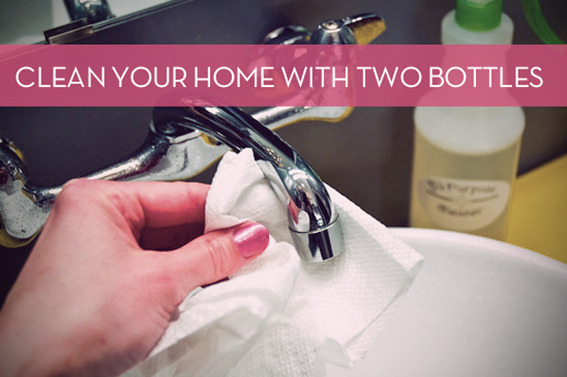I used to lug around a huge bucket full of cleaning products. And rubber gloves. And a bunch of plastic brushes, scrubbers, and a roll of paper towels. All over my house.
Then, I realized I was spending an arm and a leg on store bought cleaning products, and filling my house with chemicals neither my family nor the environment needed. And that bucket was hea – vy.

So, I came up with these two easy-to-remember recipes, using just two non-toxic ingredients and some water, and now, I can easily clean my entire house-top to bottom, on the cheap.
The Cleansers
My two go-tos are:
- DIY All-Purpose Cleaner: 1 part vinegar, 1 part water, juice from 1/2 lemon
- Anti-Bacterial Cleaner: 1 part vinegar, 1 part water, 8 drops of tea tree oil
I no longer need rubber gloves, a gas mask or a giant basket overflowing with toxic products.
How to Use ‘Em
Let’s start our spring cleaning in the kitchen with the one thing I loathe to clean…
The Oven:

Ew. Gross. Embarrassing.
I start by pre-heating my oven to 400 degrees. Once it’s preheated, I shut the oven off and leave the door closed for a few minutes.

I then use the All-Purpose Cleaner while the oven is still warm to the touch.

For really stubborn grease, you can sprinkle baking soda on the problem area.

And voila! No need to wear a mask, lay down newspaper or use that awful oven cleaner that causes you to cough endlessly.
The Kitchen:

You can clean your kitchen cabinets, microwave, refrigerator, trashcans (inside and out) with the All-Purpose Cleaner.

Next, polish up chrome and stainless steel using the same All-Purpose Cleaner.
The Bathroom:

Spotty mirrors or dirty windows?

Spray a little All-Purpose Cleaner and watch that glass shine, streak-free.

Remove gunk and mineral deposits from sink faucets, shower heads and knobs with the All-Purpose Cleaner.

Using the Anti-Bacterial Cleaner, scrub the bathtub, the toilet, toilet handle and inside the toilet bowls. For extra scrubbing power, sprinkle a little baking soda in the problem area.
Rest O’ the House:

Wipe down walls, ceilings, crown moulding and baseboards with the All-Purpose Cleaner.

Use the Anti-Bacterial Cleaner for doorknobs, light switches and anywhere else that is frequently visited by grimy hands.

Remove stains and gunk from carpet with the All-Purpose Cleaner. Just spray a little on the stain…

…use a wet sponge and wipe clean.

Remove gooey residue from table-tops, chairs, and counters with the All-Purpose Cleaner. This also cleans desktops, nightstands, bookshelves, coffee tables and more.

In summation, one bottle All Purpose, one Bottle Antibacterial, some washable rags for each, one scrubby sponge, and a bit of baking soda. No gas mask required.
What are your favorite home-made cleansers? Give me your best tips in the comments!
 Rebekah Greiman is the creator of Potholes and Pantyhose, a web blog dedicated to original DIY projects. Rebekah’s detailed tutorials are written to educate and entertain, while highlighting crafts, home decor, recipes, remodeling and more. See them all at Potholes and Pantyhose.
Rebekah Greiman is the creator of Potholes and Pantyhose, a web blog dedicated to original DIY projects. Rebekah’s detailed tutorials are written to educate and entertain, while highlighting crafts, home decor, recipes, remodeling and more. See them all at Potholes and Pantyhose.

When cleaning mirrors always spay on the cloth you’re cleaning with not on the mirror directly. (Ask any mirror specialist)
If you are using castile soap for cleaning, save yourself some money and male it yourself. It is a simple recipe and can be made in a crockpot. Once used for making soap don’t use with food.
First off, I would like to say that I pinned this article because I found it inspirational in making my own cleaning products, and doing more research in how to clean my home with fewer products (I hate having things sit on shelves and never get used). However, I have done a lot of experimenting and research since pinning this.
1- It looks like you have laminate cabinets, which is why your vinegar solution is ok for your cabinets. Anyone with wood cabinets should use a very diluted vinegar solution (like 2 Tbsp per quart) or it will eat away the finish on any finished wood surface.
2- To actually clean everything in your home, you need more than 2 bottles, because different homes will have different surfaces, which need different treatments.
3- Essential oils of any kind are only effective at killing germs if used full strength. And who can afford that?? Google it, there are people who have done experiments, with petri dishes and everything.
4- Don’t mix vinegar with soaps in the same bottle, ESPECIALLY oil-based soaps like castile. Even with dish soap, the vinegar will break it down, causing the oil to separate from the rest of the soap.